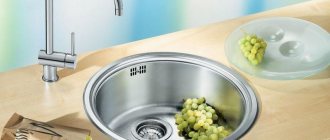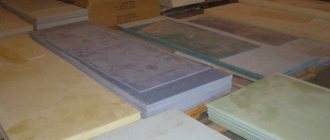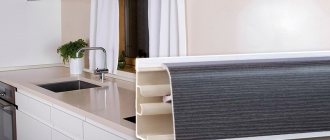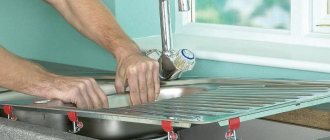/Repair/Plumbing/
A kitchen sink made of artificial stone has the most controversial “reputation”. Sometimes they are called the best, and sometimes they are called the worst of all. For example, users often complain about indelible stains, chips, scratches and even... a falling off bottom.
- Confusion in concepts is largely to blame for the conflicting reviews. After all, “artificial stone” is often called both acrylic stone and granite/quartz agglomerate. Meanwhile, these two materials are very different from each other despite their external similarity.
In this article we will look at different types of artificial stone, compare this material with ceramics and stainless steel, and also give some tips on choosing and using “stone” sinks.
Tip 2. The optimal ratio of stone chips and binder base is 80:20
Any artificial stone consists of a mineral component (granite or marble chips) and a binding component (polymer or acrylic resins). The quality of washing directly depends on their percentage in the composition. Each manufacturing material and patented name. For example, Franke called his “stone” fragranite, Blanco – silgranite, Teka – tegranite, and Omoikiri – tetogranite. How do you know which composite sink is better?
- They say that the more stone chips and less resins in the material, the better. However, not everything is so simple here.
The fact is that the more stone chips in the material (for example, 85%) and the less binder, the more resistant to scratches and high temperatures the sink will be. But at the same time it becomes less impact resistant. And vice versa: sinks with a predominant binder component are more impact-resistant, but less resistant to scratches and contact with hot dishes/boiling water. Therefore, you should choose a sink made of artificial stone based on your needs. If you rarely use heavy cookware, then it makes sense to choose a model with a high mineral content.
- Do you want to choose the average option? Look for a sink in which the proportion of stone chips is 80%, respectively the proportion of binder and additives is 20%.
Design
After choosing the material, it is worth deciding on the appearance of the sinks, their size, color and configuration. The price of the product, its convenience and the joy of the owner depend on these factors.
Surface color and type
Dyes are used in the manufacture of stone sinks, so theoretically it is possible to obtain a product of any shade. But most often, manufacturers give the shells natural colors to make them look like real stone. The most popular options:
- black;
- white;
- grey;
- beige/brown/sand.
Occasionally in the collections of some companies you can find more extravagant tones:
- green;
- pink;
- blue and others.
If you make a sink to order, then you can really give it any tone - even neon green.
To achieve maximum resemblance to natural wood, manufacturers make sinks not monochromatic, but with a specific pattern that imitates a natural surface. Such products with a pattern of crumbs or stones are much easier to care for, since small dirt is invisible on them. From this point of view, there are two ideal options:
- light shell with dark specks;
- dark shell with light specks.
Since natural stone most often has a matte surface, artificial stone is also designed in the same form. The goal is still the same - to achieve maximum resemblance to a real stone.
If you want something more original, then you should take a closer look at the glossy or silky-matte surface, as well as sinks made using shagreen and antique techniques. This structural surface will give the impression that the sink was carved out of a block of stone.
Shape and size
The size and shape of the sink is chosen based on the frequency of its use and the area of the kitchen. Often it is the last factor that remains decisive. But the variety of sink shapes will allow you to choose the ideal model even for a tiny kitchen, for example, in a Khrushchev-era building.
According to their shape, stone sinks are distinguished:
- rectangular and square are the most compact but spacious models. Comfortable for washing dishes;
- round (oval) - look interesting, but do not have a large capacity. They will look great in a classic kitchen or in Provence style;
- corner - allow you to make the most efficient use of corner space. They come in rounded or trapezoidal shapes. They cost more than regular copies;
- non-standard - made to order. It is important to listen to a sense of proportion, since a sink is, first of all, a functional product.
If we talk about sizes, the standard width is 60 centimeters. If the kitchen is small, then you can pay attention to more compact specimens, for example, 45–50 centimeters wide. Typically, these sinks are made deeper than standard ones to compensate for their small size.
If there is such an opportunity, then you can leave 80–120 centimeters of the countertop under the “wet” sink area by installing a sink not with one bowl, but with several, and also with a wing.
Multiple bowls and wings available
In a small kitchen there is often only one bowl, sometimes complemented by one wing for drying dishes. Designers often advise ditching the wing if your closet already has a drying rack or dishwasher.
In fact, the functions of the wing are much broader - you can place hot dishes here or leave food items to defrost.
If space allows, it is better to choose a sink with a second bowl. Such a sink is even more functional; for example, dishes are washed in one bowl, while vegetables and herbs are soaked in the second at the same time. It is very convenient and hygienic.
Usually bowls are selected in different sizes, but you can choose the same ones. Some people install sinks with three bowls, but this can only be done in very spacious kitchens where culinary processes are very active. Double or triple sinks will be complemented by a wing, on which it will be convenient to dry vegetables after washing.
There are models with two wings, but their practicality remains questionable. Such large sinks are usually equipped with more professional faucets - with a pull-out spout, chrome or matching the color of the sink. But if the distance between the bowls is very small, then a conventional faucet with a rotary mechanism will be sufficient.
Tip 6. DO NOT buy a “stone” sink if...
Here are 3 cases when you should choose a stainless steel model instead of an artificial stone sink:
- If you want to purchase a sink paired with a shredder. The fact is that due to vibrations and the weight of the chopper itself, the sink can crack (especially acrylic ones). In this case, it is better to choose stainless steel.
- If you are used to accumulating dishes in the sink, for example, for washing in the dishwasher. Stagnant water, liquids and pieces of food leave a residue on the bottom and sides of the bowl.
- If practicality is your priority over aesthetics, only a stainless steel sink will give you the opportunity to:
- Drain the boiling water without turning on the cold water;
- Shake off any remaining food from a fork or spatula against the side of the bowl;
- Place hot dishes on the sink drain;
- Do not wash dishes immediately.
Which sink is better: marble, granite or quartz?
The answer is simple: all composites that imitate the listed natural rocks have good physical and mechanical properties and meet the requirements for household items. The choice is more a matter of taste and design. And yet, a sink made of marble or granite, which is better? What are the differences?
- Marble is a rock formed from limestone. It consists almost entirely of calcium, and a small admixture of iron (and other) oxides gives it a characteristic pink, creamy, greenish tint. Marble products are matte, with a warm surface, plastic. It absorbs dyes quite easily, so it is advisable to cover them with a protective layer.
- Granite is an igneous rock, much harder and more durable than marble. 55–65% of it is composed of quartz, the rest is feldspars and other minerals. This explains its “variegated” texture and variety of colors. It is more difficult to polish, the surface remains a little rough - it is perhaps most similar to “stone”.
- Quartz is a hard, brittle mineral that, when melted and fired, takes on a shiny, glassy appearance (the main component of glass). Polymer resins give the quartz sand-dominated material the necessary impact resistance.
The speckled pattern of granite is practical; stains and minor defects are not visible on it. Marble requires more careful handling and is more often used in classic-type interiors. Quartz sinks are not afraid of high temperatures, but not everyone likes their cold “glass” appearance.
5. The countertop and sink look like polished granite.
6. Stylish sink made of a composite with a predominance of quartz.
Comparison of sinks made of artificial stone with sinks made of stainless steel, ceramics and natural stone
If you are viewing the table on a smartphone, turn it to a horizontal position so that the entire table fits into the screen area.
| Acrylic stone | Artificial granite/marble/quartz | Stainless steel | Ceramic sink | |
| Easy to clean | – | +– | + | +– |
| Noise absorption | + | + | — *The problem is partially solved by a layer of sound insulation, which is attached to the bottom on the back side of the bowl. In addition, a lot depends on the thickness of the steel. If it is thick, then the sink will be almost silent. | +- *The ceramic sink does not rattle when water flows from the tap, but it can “ring” when it comes into contact with dishes |
| Scratch resistance | — | + | — | + |
| Resistant to impacts and falling heavy objects | — | +- | + | — |
| Invisibility of drops, streaks and deposits from hard water | + | + | — | + |
| Possibility of local repairs (grinding scratches, chips) | + | + | — | — |
| Resistance to contact with hot dishes | — | + | + | + |
| Resistance to sudden temperature changes | — | + | + | — |
| Chemical inertness | — | +- | + | +- |
| Price | Low | Medium and high | Low and medium | High |
Support the project - share the material with your friends on social networks:
The best manufacturers
A stingy man pays twice - this saying is very useful when choosing a composite sink. Buyers who want to save money buy very inexpensive models, but after a few months they begin to complain about the appearance of chips, cracks, and discoloration. Of course, then more expensive models are purchased, since the negative experience is taken into account.
It is important not so much to look at the price tag and buy expensive products, but to know a good manufacturer and trust him. European production is considered more reliable, but Russian companies also have excellent products.
Foreign manufacturers
Among all international manufacturers, German ones are most valued, because everyone has had the impression of “German quality” since childhood.
| Schock (Germany) | They are distinguished by the highest quality of their sinks, which consist of a patented material Kristalite (85% granite). Large assortment, various configurations. “Shock” offers the most innovative solutions, for example, a sink with built-in lighting. My models are made in Germany. |
| Franke (Switzerland) | It also has a patented material - Fragnite, the composition of which is 80% granite and 20% acrylic. The presence of acrylic in such quantities in no way affects the quality - the sinks are very durable and can cope with loads without problems. In addition to sinks, Franke also has a number of appliances and accessories for the kitchen. |
| Blanco (Germany) | Another German manufacturer that has a patented composition is Silgranit, which consists of 80% granite. Thanks to this, the performance characteristics are maintained at a high level: the sink does not fade, is not afraid of temperatures, and is resistant to scratches and other influences. In addition, Blanco also thought about aesthetics: the design is on point. |
| Teka (Germany) | Teka has patented a material called Tegranit Plus, which consists of 70–80% granite chips, 19–25% acrylic binders and another 5% pigments. A very wide range of shapes, sizes and shades. |
| Longran (Italy) | The patented material of this brand is called Lonstone - it consists of 80% granite chips and can withstand heating up to 280 degrees. They are made not only in Italy, but also in Turkey and India. They have a stylish design. |
| Alveus (Slovenia) | The brand, which belongs to PC Inox, has not avoided the tendency to patent its compositions. Its material is called Algranit, and it consists of 70% granite and 30% acrylic bonding material. In total, the brand has more than 300 sink models, among which you can find the perfect one. Alveus also produces household appliances and kitchen accessories. |
Domestic manufacturers
But even among Russian brands there are those that are of excellent quality. At the same time, the price tag for them is lower than for foreign products. It is worth taking a closer look at the following brands.
| Polygran _ | This company produces products under two brands - Polygran and Tolero. The products are distinguished by favorable prices, good quality and a large assortment. |
| Granfest _ | It has been on the domestic market for more than 15 years, has its own design bureau, so it offers a wide range of colors, sizes and shapes. It also produces faucets and sanitary accessories. Owns the Ewigstein trademark. |
| Florentina _ | A growing brand from Russia. The line is not very large - only about twenty models, but most of them were developed by European designers. An excellent option when you want to get a quality product, but don’t want to overpay for the brand. |
| Granula _ | Russian leading brand that uses European raw materials. In addition to sinks, it also supplies faucets to stores. It is of good quality. |
It is worth noting another Russian brand - Ulgran.
But this manufacturer collects more negative reviews than positive ones. For example, owners complain about instability to temperatures and influences. That is why it is worth reading reviews for the selected model in advance. For example, there is another domestic manufacturer - Granmill, but it only makes sinks from marble. Regarding the material itself, the products are of high quality, but granite analogues will still be better.
Also among the popular Russian manufacturers are:
- Ecostone;
- Mixline;
- Dewdrop;
- Maxstone;
- Aquasanita
- Marrbaxx.
These sinks are rarely included in the ratings of top manufacturers, but here you can find a high-quality and inexpensive product.
Low-quality products or even counterfeits of a well-known brand will be revealed by the packaging. Famous brands use thick cardboard with stiffeners for better fixation of the product. There is also a holographic sticker. The fake will get a frail cardboard without identification marks.
Even if the packaging has passed all the tests, it is worth paying attention to the product itself and checking its geometry. A tape measure will be useful for this: the walls should be 9–12 mm thick, and the surface should be uniform. It is best to buy your kitchen sink from big box stores or dealers.
What are the disadvantages
Do not place dishes in quartz sinks that have just been removed from the burner. Contact with hot material from a pot or pan may leave a mark on the surface of the sink. In this property, stainless steel outperforms composite.
The surface of many quartz kitchen sinks is coated with a special gelcoat-based compound. As a result, a decorative protective layer is formed on the product, which can be easily washed off from dirt with a soft sponge and ordinary detergents.
The sink cannot be cleaned with metal brushes or abrasive powders due to the high probability of damage to the surface. For some users, such restrictions are a significant disadvantage; they are used to scrubbing the sink with scourers made of metal threads.
Note! The advantage of quartz sinks is their high strength, however, if a large cast iron frying pan is dropped onto it from a height of half a meter, mechanical damage may occur.
For many buyers, the most important factor characterizing a product is price. For quartz sinks it is rather large, which is a disadvantage for a large number of potential owners, so they choose stainless steel.
The desire to buy is strengthened by the opportunity to use a beautiful, original sink. It will serve for many years without losing its attractiveness.
Installing a heavy sink requires the participation of several specialists. If the product has a non-standard shape or size, then diamond cutters will be needed for installation. The process may take several hours, but the result will be enjoyable every day.
Composite kitchen sinks are not without some disadvantages; they have both pros and cons, so manufacturers and experienced users warn about the specifics of their use.
Advantages of a quartz kitchen sink
The sink and the adjacent surface, made of quartz composite raw materials, appeared on the market relatively recently, but managed to impress users with a combination of the following positive qualities:
- appearance reminiscent of natural stone;
- ability to absorb the noise of falling water;
- absence of loud sounds when washing dishes (not like in stainless steel);
- smooth, uniform surface;
- resistance to detergents;
- environmental friendliness;
- durability;
- ease of care;
- possibility of repairs.
What to look for when choosing?
In an effort to overtake competitors, manufacturers are constantly improving the composition and design of their products. Therefore, when choosing a sink for the kitchen, you need to carefully read the instructions included with it. It is worth paying attention to the following characteristics.
- The content of mineral chips should not be lower than 80%. More resin will reduce heat resistance and strength.
- The composition of the stone filler - the more quartz, the better the abrasion resistance. But at the same time, fragility will also increase: granite sand is optimal in this regard.
- Temperature range - this indicator varies widely, from 200 to 500 degrees (in any case, you should not put pans in the sink directly from the stove).
- Antibacterial and dirt-repellent additives - they improve the quality of the material, facilitate maintenance and extend the service life of the product.
- There are sinks on sale without a cut-out hole for the faucet; this can be useful, since the wing can be turned in any direction.
The problem of which sink to choose, and which is better, artificial marble or granite, is solved depending on how actively it is used. The choice is also influenced by the style of interior design, and when it is installed: during a major renovation, or an old sink is being replaced without the intention of radically changing the furniture and appearance of the room. One thing is good: there are many offers, and you can find an option that suits the price and quality.
Kitchen plumbing fixtures are typically made from various types of metal alloys to ensure strength and durability.
A successful alternative to metal as a material for making sinks is a quartz composite containing a small amount of binding and coloring components.
Kitchen sinks made of quartz are not inferior to stainless steel containers, and surpass them in many consumer properties. The new material has found a large number of supporters, its position in ratings assessing the quality of plumbing fixtures for the kitchen is actively increasing.
How is quartz composite made?
Excellent consumer characteristics of quartz material for the manufacture of kitchen sinks, which has almost no disadvantages in its properties, are ensured by the implementation of the following technological stages of production:
- thorough mixing of the feedstock;
- homogeneous mass casting;
- molding products by pressing;
- hardening by thermal load;
- polishing surfaces.
The final stage is mandatory monitoring of quality indicators, preparation of a conclusion on the absence of disadvantages or defects in the product.
Some consumers do not see the difference between artificial quartz and artificial acrylic stone, believing that their composition is similar. In fact, the quartz composite used to make kitchen sinks contains a predominant portion of natural, non-porous silica. This is a huge advantage to the properties of the raw material. There is no natural component in acrylic stone, which is a big disadvantage.
Features of the stone
To make shells, manufacturers use one of the following mixtures:
- 60-80% composite (quartz sand, crushed marble, granite);
- 20-40% binder material (acrylic resin, polymer).
To strengthen the surface, the sink is covered with a dense composition - gelcoat. It fills pores, gives smoothness, and increases service life. The protective layer is resistant to chemicals.
Stone sinks are made by vibration casting. The raw materials are placed in fiberglass molds and processed on a special unit that creates vibrations with a given amplitude and intensity. The result is a strong, evenly colored product. The technology allows you to create sinks of different styles and dimensions.
Rules of care
[blok_4_h2]
To keep your sink always like new, you need to use it correctly and take care of it regularly. Follow the rules:
- Start care from the day of installation;
- After washing the dishes, go over the walls and bottom with a sponge and detergent and rinse them with water. Then wipe dry;
- To place hot dishes, use metal or wooden trivets;
- To prevent cracks from temperature changes, turn on cold water before draining the boiling water.
Tip: If you don’t want to dry your sink often, buy a white, beige or variegated sink. Water will also leave a light salt coating on them after drying. But on light and variegated surfaces they are lost. Then care comes down to washing the sink only once a week.











